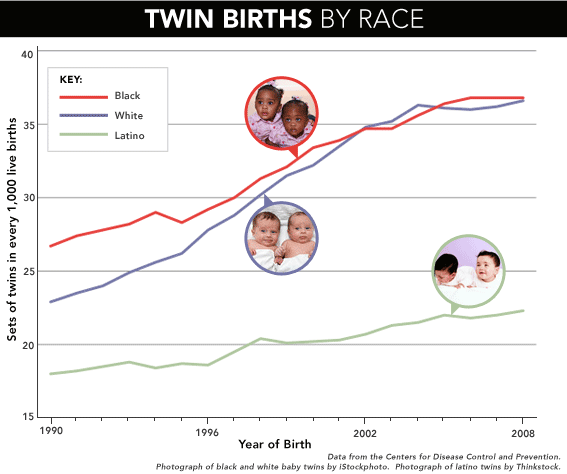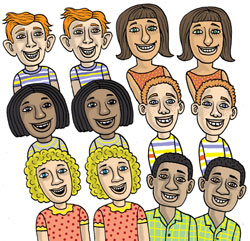Are Twins Taking Over?
Making sense of the dramatic rise in multiple births.
Twenty-five years ago, almost no one had a cell phone. Very few of us had digital cameras, and laptop computers belonged only to the very rich. But there is something else—not electronic, but also man-made—that has climbed from the margins of the culture in the 1980s to become a standard accoutrement in upscale neighborhoods across the land: twins.
According to the latest data from the Centers for Disease Control and Prevention the U.S. twin rate has skyrocketed from one pair born out of every 53 live births in 1980 to one out of every 31 births in 2008. Where are all these double-babies coming from? And what's going to happen in years to come—will the multiple-birth rate continue to grow until America ends up a nation of twins?
The twin boom can be explained by changes in when and how women are getting pregnant. Demographers have in recent years described a "delayer boom," in which birth rates have risen among the sort of women—college-educated—who tend to put off starting a family into their mid-30s or beyond. There are now more in this group than ever before: In 1980, just 12.8 percent of women had attained a bachelor's degree or higher; by 2010, that number had almost tripled, to 37 percent. And women in their mid-30s have multiple births at a higher rate than younger women. A mother who is 35, for example, is four times more likely than a mother who is 20 to give birth to twins. That seems to be on account of her producing more follicle-stimulating hormone, or FSH, which boosts ovulation. The more FSH you have in your bloodstream, the greater your chances of producing more than one egg in each cycle, and having fraternal twins as a result.
Older mothers are more likely to have twins, but they're also more likely to use in vitro fertilization or other reproductive technologies in order to get pregnant. IVF increases twinning rates, too. Treatments begin with "ovulation induction," in which FSH or other drugs are prescribed to the would-be mother, to help her release multiple eggs in a given cycle. That way the doctors can try to maximize their chance of success by creating a whole bunch of fertilized embryos and then transferring several of them at a time into the mother's uterus. Something like 25 to 30 percent of women treated with IVF end up having multiple births.
The two factors described above—delayed motherhood and in vitro fertilization—are, of course, related: The longer you wait to have kids, the more likely it is that you'll need IVF; and the easier it is to get IVF, the more likely it is that you'll wait to have kids. There's a socioeconomic link, too: The well-educated women who tend to put off starting a family are also the ones most able to afford a $20,000 fertility treatment. One can deduce, then, that twin rates across the country should correspond both with rates of educational attainment and average income. For the most part, the following maps support that hypothesis.
(Compare twin rates with nationwide trends in the widget below. Select a national dataset from the dropdown menu on the right, and compare it with the pattern of twin birthrates shown on the left.)
Better-educated, richer parts of the country do produce more twins than anywhere else. Connecticut, for example, is the wealthiest state in the union (its residents made an average of $56,272 per capita in 2008) and it ranks in the top three when it comes to education (35.6 percent of its residents held a bachelor's degree). It's also in the top three for the availability of IVF clinics, with 2.52 per 1 million residents. And its twinning rate—43 for every 1,000 live births—is third in the nation.
Now look at New Mexico, which is near the middle for education (24.7 percent of its residents hold a B.A. or higher) and ranks near the bottom for average income ($33,430), with very few IVF clinics around (0.49 per million residents). Its twinning rate is the lowest in the United States, at 24.7 per 1,000 live births.
But there are some places where the theory breaks down. Consider the Deep South, where five of the poorest states in the country consistently produce above-average numbers of twins. The mean income across the belt running from Louisiana to South Carolina is just $33,630 (barely higher than New Mexico's), and the average rate of college education is a meager 22.6 percent; IVF clinics are few and far between. Yet the combined twinning rate for these states is 32.9, which far exceeds New Mexico's, and other states with similar socioeconomic profiles. In fact, the twinning rates in the Deep South match up with those of pretty well-to-do states like Nebraska, North Dakota, and South Dakota. What's causing this twins paradox?
Along with Maryland and the District of Columbia, those states have the highest proportions of black residents in the nation, and it turns out that black mothers are more likely to have twins than those of any other racial group. It has been known for decades that levels of FSH production differ among subpopulations in the U.S. and overseas. Black women in African countries produce more FSH than anyone else, and they have the highest fraternal twinning rate in the world. Women in East Asian countries, on the other hand, have the lowest FSH-levels and produce few twins. (In the U.S., twins are significantly less common among Latinos than among whites or blacks, which may help to explain the low twinning rates in New Mexico, Arizona, and Texas.)

Since these racial differences appear to be based on relative levels of FSH, the effect shows up in fraternal, as opposed to identical, twins. Fraternal twins are much more common than identical twins as a general rule: In the U.S., they constitute 70 percent of all twin births, and there's every reason to believe they're the main source of the recent twin boom. However, there are indications that identical twins are on the rise as well. In England and Wales, for example, the rate started going up in 1970. That may be attributable to the use of oral contraceptives: According to one theory, women who get pregnant shortly after being on the pill end up having more monozygotic twins. It's also possible that assisted hatching, a method used in conjunction with IVF to increase the probability of implantation, alters the structure of the fertilized egg membrane in such a way that the odds of a split embryo are increased.
In any case, the graph above suggests that the development of reproductive technologies has eliminated the twinning gap between black and white mothers in recent years. The first IVF child born in the U.S. came in 1982 *, and rates of multiple births have increased in a virtually linear trend for women of all races ever since. The effect has been most dramatic among white women—surely on account of long-standing racial inequalities in education and income.
But the graph also reveals what looks to be a leveling off of twin rates in the past few years.We don't know exactly why this is happening, but it's possible that doctors have simply gotten better at performing IVF, so they're able to complete the procedure while transferring fewer embryos. The latest numbers show that in 2009, doctors implanted an average of two embryos during treatment—down from about six embryos in 2003.
Doctors may be getting better at their job, or maybe they're just showing more restraint. In countries where reproductive technology is more closely regulated, governments cap the number of embryos that can be implanted into a womb. England, for instance, allows a maximum transfer of three embryos. In contrast, American mothers make this decision with their physicians, and there are no hard and fast rules. Nadya Suleman had 12 embryos transferred—six times the recommendation for a woman her age—en route to her infamous octomotherhood. But concern over the possibility of premature babies—since multiples tend to come earlier than singletons—has led some in the U.S. to call for European-style restrictions on IVF treatment. Groups such as the Society for Assisted Reproductive Technology and the American Society for Reproductive Medicine have also created guidelines recommending best practices for embryo transfer according to a patient's age.
Whatever their motivation, IVF doctors seem to be transferring fewer embryos over time. Will that be enough to counteract the delayer boom and keep twinning rates level in years to come? We'll have to see. A twin takeover may yet be on the horizon.
Correction, Aug. 24, 2011: The article originally implied that the first IVF child born in the U.S. was also the first overall. In fact, an IVF child was born overseas in 1978. (Return to the corrected sentence.)
